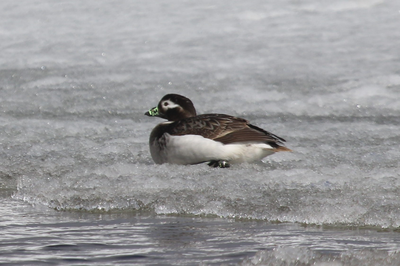Migration and distribution patterns
Intra- and interspecific differing migratory behavior of seabirds
Migration is an integral part of the ecology of many species; birds in particular cover long distances in their migratory movements due to their ability to fly. These species are therefore particularly affected by climate and environmental changes. Changes at individual points in their distribution (wintering areas, summer ranges, migratory routes) can already have a massive impact on a species, but the accumulation of different changes at different locations also poses a threat to migrating species. Therefore, to effectively protect such species, it is especially important to know their migration patterns, distribution patterns, life cycles and annual cycles.

Photo: Alexander Kondratyev
As part of a study1 of long-tailed ducks (Clangula hyemalis), which were classified as vulnerable by the IUCN in 2012, the spatiotemporal distribution and, in particular, the exact location of their wintering grounds were therefore investigated. Thus, female long-tailed ducks on Kolguyev were equipped with geolocators for one year. This showed that the individuals studied spend up to 58% of the year in the Baltic Sea, their wintering area. These results particularly underline the importance of protective measures in the Baltic Sea, where long-tailed ducks can die as bycatch in gillnets, for example.1
Female long-tailed ducks return to the same area each year to breed. Pairs re-form each year and male long-tailed ducks follow females to the breeding area after pair formation in wintering areas. Therefore, unlike females, males cannot be specifically recaptured to retrieve geolocators for data analysis. Thus, data on migratory movements of male long-tailed ducks is very sparse. To fill this gap, male and female long-tailed ducks on Kolguyev were equipped with ARGOS satellite transmitters for a study2, from which movement data were received for an average of 369 (females) and 356 days (males), respectively. In particular, there were clear differences between the sexes in the distribution during the molt, females remained predominantly in the breeding area while males took long distances and molt in the area of the northern Yamal and Gydan peninsulas. The results also confirmed the special importance of the southern Baltic Sea as a wintering area.2
However, in addition to the destination of migratory movements, temporal coordination is also relevant. Areas with a large food supply or optimal breeding areas attract a high number of animals of a wide variety of species. They are therefore places with high intraspecific competition. To investigate the avoidance of such competitive situations through ecological segregation by means of temporal differences in migration behaviour, three petrel species (Procellariidae) were equipped with geolocators for a study3. Thin-billed prions (Pachyptila belcheri), blue petrels (Halobaena caerulea), and Antarctic prions (Pachyptila desolata) are closely related species that breed sympatrically on islands in the southern Indian Ocean and were therefore particularly suited for this study. There were clear spatiotemporal differences between the three species during the early breeding season, avoiding competition for food and breeding sites (Fig. 1)3. This is consistent with previous studies that have demonstrated such segregation for the wintering period. Comparison with geospatial data from the wintering period also illustrated that thin-billed prions and blue petrels exhibited niche-tracking, migration between habitats with comparable environmental conditions. In contrast, Antarctic prions engaged in niche-switching, migrating between habitats with different environmental conditions.3

Fig. 1: Chronology of the early breeding season of Blue Petrels, Thin-billed Prions, and Antarctic Prions from the Kerguelen Archipelago; the size of the circles correlates with the number of individuals entering or exiting a phase3
References
1. Karwinkel T, Pollet IL, Vardeh S, Kruckenberg H, Glazov P, Loshchagina J, Kondratyev A, Merkel B, Bellebaum J, Quillfeldt P (2020): Year-round spatiotemporal distribution pattern of a threatened sea duck species breeding on Kolguev Island, south-eastern Barents Sea. BMC Ecology 20:31. DOI:https://doi.org/10.1186/s12898-020-00299-2. https://bmcecol.biomedcentral.com/articles/10.1186/s12898-020-00299-2
2. Quillfeldt P, Morkūnas J, Kruckenberg H, Kondratyev A, Loshchagina J, Aarvak T, Øien IJ, Bellebaum J, Glazov P. (2022) Year-round movements of Long-tailed Ducks Clangula hyemalis from Kolguev Island, Barents Sea. Polar Biology 45: 71-87. DOI:https://doi.org/10.1007/s00300-021-02973-7. https://link-springer-com.ezproxy.uni-giessen.de/article/10.1007/s00300-021-02973-7
3. Quillfeldt P, Weimerskirch H, Delord K, Cherel Y (2020): Niche switching and leapfrog foraging: movement ecology of sympatric petrels during the early breeding season. Movement Ecology 8: 23. DOI:https://doi.org/10.1186/s40462-020-00212-y. https://movementecologyjournal.biomedcentral.com/articles/10.1186/s40462-020-00212-y
